March 2025
Significant Weather Events:
March was a historical month for significant weather, from damaging tornadoes and dust storms to large wildfires. Keying in on some of the significant dust and fire weather events we begin on March 3rd. On March 3rd winds were gusting to 55 to greater than 65 miles per hour in the Texas Panhandle. These winds lifted copious amounts of blowing dust, which resulted in critically low visibility. Two other significant blowing dust events occurred in the Texas Panhandle in March. One on the 15th and one on the 18th. Of these two events, March 15th proved to be the most impactful, resulting in 42 vehicular crashes, of which three were fatal. Several of these crashes included multiple vehicles, including a pile-up south of Canyon, Texas which involved about 38 vehicles.
The high wind speeds that resulted in these three different dust storms also led to the increased potential for critical fire weather. From March 13th to the 15th dangerous fire weather conditions were observed in Texas, Oklahoma, and Arkansas. Several fires ignited in Central and South Texas, but thankfully they were extinguished fairly quickly. In Oklahoma though, more than 130 fires were reported in 44 different counties on March 14th, according to the Oklahoma Department of Emergency Management. One of the most impactful of these fires was in Stillwater, OK where over 75 structures were lost to flames.
March began meteorological spring and with that, we saw no shortage of severe and damaging thunderstorms across the Southern Region. Beginning in the early hours of the morning on March 4th, a line of damaging thunderstorms tore through the Dallas-Fort Worth Metroplex before moving east to Shreveport, LA by daybreak. This storm system brought powerful straight-line winds of over 80 mph and a few isolated tornadoes. Three injuries were reported in Franklin County Texas.
This severe weather outbreak was followed by a multi-state, multi-day deadly tornado outbreak in the Southeast United States. On March 14th in Arkansas alone, two EF-4 tornadoes were observed, one in Franklin and the other in Diaz. There were 6 reported injuries from these storms in Arkansas, and many people lost their lives to these storms in Missouri. By the following morning, these storms had tracked east into Mississippi and Tennessee. Two strong tornadoes, one near Marion County and the other near Covington County, took a combined 7 lives and injured 16 additional individuals. This tornado outbreak had far-reaching impacts with at least 43 people killed across eight states, according to FOX Weather. With a total of 117 confirmed tornadoes, this became the largest tornado outbreak ever recorded in March.
Temperature:
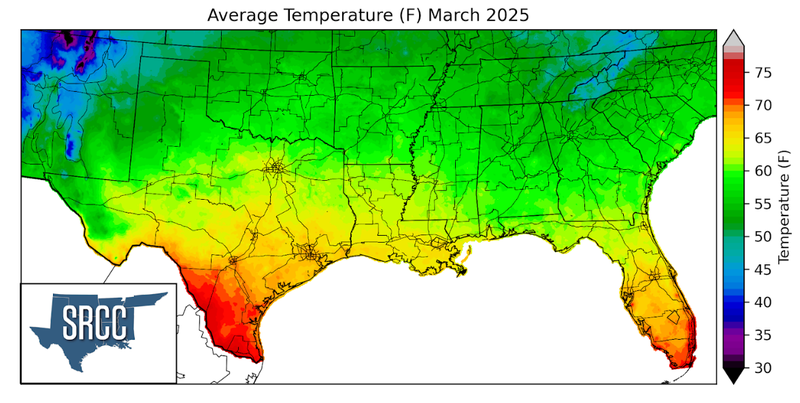
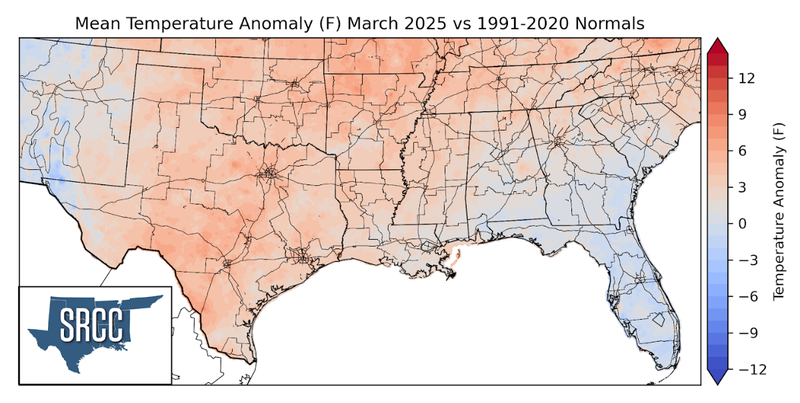
The monthly average temperature for March was slightly above normal for the Southern Region. There were no significant departures from normal, as much of the Region hung around 3 to 5 degrees Fahrenheit above normal. Temperatures in the first week of March were near normal, with no significant records broken. By the second week of March though, things started to heat up and it felt a lot like spring outside. March rounded out with a week of below-normal and another week of above-normal temperatures as sometimes a strong cold front would come through, cooling things down. Monthly average temperatures ranged from 70 degrees in Deep South Texas to around 50 degrees in the Oklahoma Panhandle and the Great Smoky Mountains.
Precipitation:
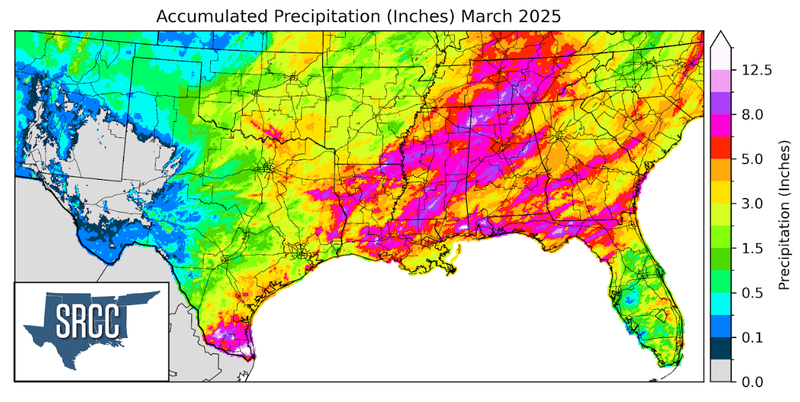
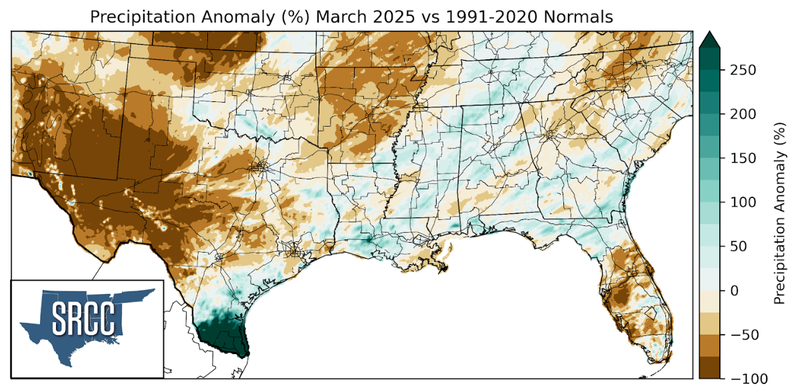
Departures from normal precipitation varied widely across the Southern Region. West Texas, Central Texas, Northwest Oklahoma, and Arkansas all saw precipitation totals less than normal for the month of March. Meanwhile, Deep South Texas saw precipitation totals three times normal! Much of this rain fell on March 28th, where weekly precipitation totals were 6 inches to a foot in Cameron and Willacy Counties. While precipitation totals were closer to normal in Louisiana, Mississippi, and Tennessee large quantities of rain still fell throughout March. Most areas in the three states saw 4 to 7 inches, with isolated areas receiving upwards of 10 inches. This rainfall was driven by several rounds of strong and severe weather systems that pushed through the Southeast United States. However, some areas of the Southern Region remained dry this March. Much of Far West Texas did not receive any measurable amount of precipitation this month and has not received any since sometime in January. Overall, the highest precipitation accumulations were confined to the eastern half of the region. Aforementioned, much of this rainfall can be attributed to severe thunderstorms. This is not out of the ordinary as Louisiana and Mississippi are where the highest severe thunderstorm chances are in March.
Drought:
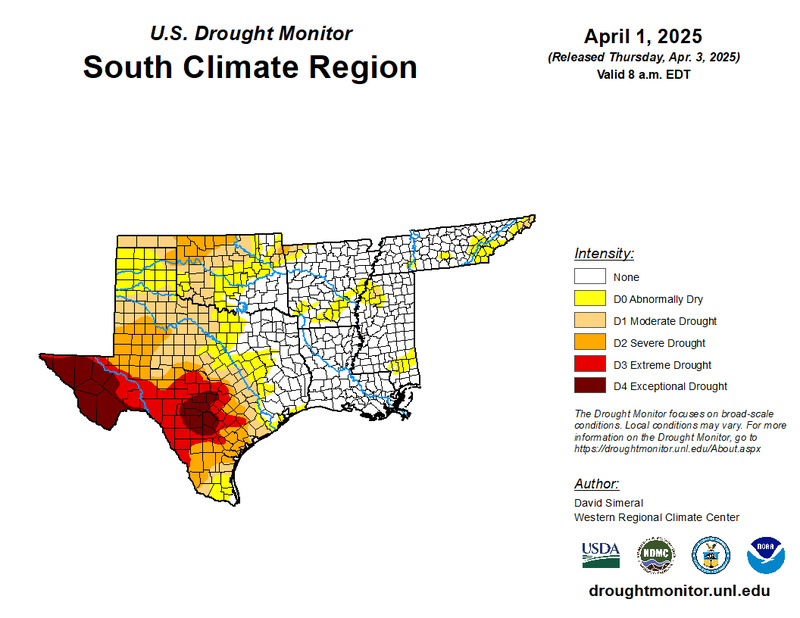
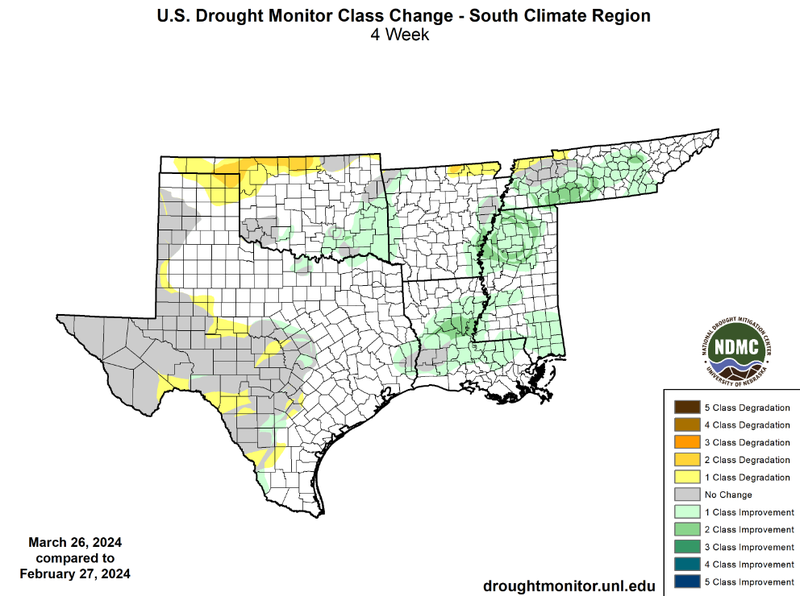
March can be characterized by spring-like temperatures and spring-time thunderstorms in the eastern states of the Region, where most of the rainfall was concentrated. Less than normal precipitation totals were observed in West Texas, Central Texas, Northwest Oklahoma, and Arkansas. This coincides with the areas where drought degradations were observed. The most widespread degradations were observed in West, Central, and South Texas where two-class and even isolated three-class degradations were observed. One and two-class degradations were also observed in Northwest Oklahoma. However, improvements were still observed in the Southern Region. Isolated one-class improvements were observed along the Texas-Oklahoma border in the Red River Basin and in Deep South Texas. Additionally, one and two-class improvements were observed in the Cumberland Plateau and the Great Smoky Mountains of Tennessee. Unfortunately, these improvements were not enough to counteract the expansion of drought in the Southern Region. Therefore, the percentage of the region experiencing drought rose nine percent from the beginning of March. Drought severity rose as well, at a regional level. From the beginning of March to the beginning of April the percentage of areas experiencing severe to exceptional drought (D2 - D4), rose by ten percent!
According to the U.S. Monthly Drought Outlook for this April, drought is expected to remain yet improve in South Texas. Drought is expected to persist in Texas and Oklahoma. Finally, drought removal is likely in areas of the Great Smoky Mountains.
